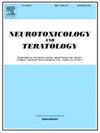产前丁丙诺啡/纳洛酮暴露与新生儿神经行为功能:初步报告。
IF 2.8
3区 医学
Q3 NEUROSCIENCES
引用次数: 0
摘要
简介:尽管在妊娠期间使用丁丙诺啡/纳洛酮的处方越来越被接受,但由于对联合用药对胎儿和新生儿的影响知之甚少,因此丁丙诺啡单药治疗更为常用。目前还缺乏对产前接触丁丙诺啡/纳洛酮的新生儿神经行为功能的评估。新生儿重症监护室网络神经行为量表(NNNS)已被用于评估因产前应激因素而面临发育改变风险的新生儿的神经行为功能、应激反应和调节能力。本试验性研究对子宫内暴露于丁丙诺啡/纳洛酮的新生儿的神经行为功能以及母亲的特征和怀孕期间存在的因素进行了描述性分析:参与者为接受阿片类药物使用障碍(OUD)综合治疗和产科护理的怀孕父母,选择丁丙诺啡/纳洛酮治疗,单胎无并发症妊娠。参与者按照协议提供保密的尿液标本,以检测合法和非法精神活性物质。在参与研究期间,我们获得了孕产妇的精神疾病和精神疾病用药以及每周用药记录。在新生儿出生后的第 3、14 和 30 天,对 16 名足月新生儿进行了 NNNS 测试:结果:在出生后第一个月的三个时间点,对产前暴露于丁丙诺啡/纳洛酮的新生儿进行了 12 个神经行为领域(注意力、唤醒、自我调节、处理、运动质量、兴奋性、嗜睡、非最佳反射、不对称反射、张力过高、张力过低和应激/戒断综合征)的平均综合评分。该样本中存在一些可能影响新生儿功能的母体因素,包括吸烟(94%)、精神病诊断(87.5%)、治疗期间合法或非法药物尿检呈阳性(56.2%):本报告提供了有关在出生后第一个月内接触丁丙诺啡/纳洛酮的新生儿神经行为功能的初步信息,包括对母体因素的考虑。不过,今后有必要对更大的样本进行研究,并控制新生儿和母亲的不同因素,以证实这些初步研究结果。本文章由计算机程序翻译,如有差异,请以英文原文为准。
Prenatal buprenorphine/naloxone exposure and neonatal neurobehavioral functioning: A preliminary report
Introduction
Although prescription of buprenorphine/naloxone during pregnancy is gaining acceptance, buprenorphine monotherapy is more often used due to the scarce knowledge of the effects of the combined medications on the fetus and neonate. Evaluation of neurobehavioral functioning of neonates prenatally exposed to buprenorphine/naloxone is lacking. The NICU Network Neurobehavioral Scale (NNNS) has been used to evaluate neurobehavioral functioning, stress responses, and regulatory capacities of neonates at risk for altered development due to prenatal stressors. This pilot study presents a descriptive analysis of the neurobehavioral functioning among neonates exposed in utero to buprenorphine/naloxone, as well as maternal characteristics and factors present during their pregnancy.
Methods
Participants were pregnant parents receiving comprehensive treatment for opioid use disorder (OUD) and obstetric care, choosing buprenorphine/naloxone treatment with singleton, uncomplicated pregnancies. Participants provided confidential urine specimens for legal and illegal psychoactive substances according to protocol. Maternal psychiatric disorders and psychiatric medications as well as weekly dosing records were obtained for the duration of study participation. The NNNS was administered to 16 full-term neonates on days 3,14 and 30 of life.
Results
Mean summary scores for 12 neurobehavioral domains (attention, arousal, self-regulation, handling, quality of movement, excitability, lethargy, non-optimal reflexes, asymmetrical reflexes, hypertonia, hypotonia and stress/abstinence syndrome) are presented for neonates prenatally exposed to buprenorphine/naloxone at three time points during the first month of life. Several maternal factors that can influence the functioning of the neonate were presented in this sample including smoking cigarettes (94 %), a psychiatric diagnosis (87.5 %), positive urinalysis for legal or illegal substances during treatment (56.2 %).
Conclusions
This report provides preliminary information regarding the neurobehavioral functioning of neonates exposed to buprenorphine/naloxone over the first month of life, including consideration of maternal factors. However, future research with a larger sample and controlling for different neonate and maternal factors is necessary to confirm these preliminary findings.
求助全文
通过发布文献求助,成功后即可免费获取论文全文。
去求助
来源期刊
CiteScore
5.60
自引率
10.30%
发文量
48
审稿时长
58 days
期刊介绍:
Neurotoxicology and Teratology provides a forum for publishing new information regarding the effects of chemical and physical agents on the developing, adult or aging nervous system. In this context, the fields of neurotoxicology and teratology include studies of agent-induced alterations of nervous system function, with a focus on behavioral outcomes and their underlying physiological and neurochemical mechanisms. The Journal publishes original, peer-reviewed Research Reports of experimental, clinical, and epidemiological studies that address the neurotoxicity and/or functional teratology of pesticides, solvents, heavy metals, nanomaterials, organometals, industrial compounds, mixtures, drugs of abuse, pharmaceuticals, animal and plant toxins, atmospheric reaction products, and physical agents such as radiation and noise. These reports include traditional mammalian neurotoxicology experiments, human studies, studies using non-mammalian animal models, and mechanistic studies in vivo or in vitro. Special Issues, Reviews, Commentaries, Meeting Reports, and Symposium Papers provide timely updates on areas that have reached a critical point of synthesis, on aspects of a scientific field undergoing rapid change, or on areas that present special methodological or interpretive problems. Theoretical Articles address concepts and potential mechanisms underlying actions of agents of interest in the nervous system. The Journal also publishes Brief Communications that concisely describe a new method, technique, apparatus, or experimental result.

 求助内容:
求助内容: 应助结果提醒方式:
应助结果提醒方式:


